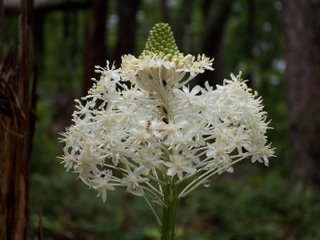
Turkey Beard (
Xerophyllum asphodeloides) has dense clusters of creamy, star-like flowers that bloom from May to July. Flowering on stalks two to four feet high, they are tough, elegant members of the lily family. The mostly basal leaves are thin (grass-like), elongated and up to two feet long. They form a tussock at the base of the plant. The genus name, xerophyllum, is from the Greek words xeros ("dry") and phyllon ("leaf") and refers to the dry, wiry leaves that compose that tussock.
NatureServe, a non-profit conservation organization, reports that they are
ranked "vulnerable" in North Carolina and Tennessee. They are ranked as critically imperiled in South Carolina, Georgia, and Alabama. They are believed to have been extirpated from Delaware and perhaps from Kentucky.
I found this new population of Turkey Beard on the Shoal Creek Ranger District of the Talladega National Forest (near Heflin, AL.) Known populations were documented from the area, but on opposing ridgetops a quarter of a mile away.
 Ruellia caroliniana (Wild Petunia) is a beautiful native wildflower that is currently blooming its heart out. Other species (Ruellia purshiana) of this plant have already bloomed this year. This plant is in the Acanthaceae family which also hosts several other native plants to Alabama, including Justicia americana (American Water Willow).
Ruellia caroliniana (Wild Petunia) is a beautiful native wildflower that is currently blooming its heart out. Other species (Ruellia purshiana) of this plant have already bloomed this year. This plant is in the Acanthaceae family which also hosts several other native plants to Alabama, including Justicia americana (American Water Willow). 


